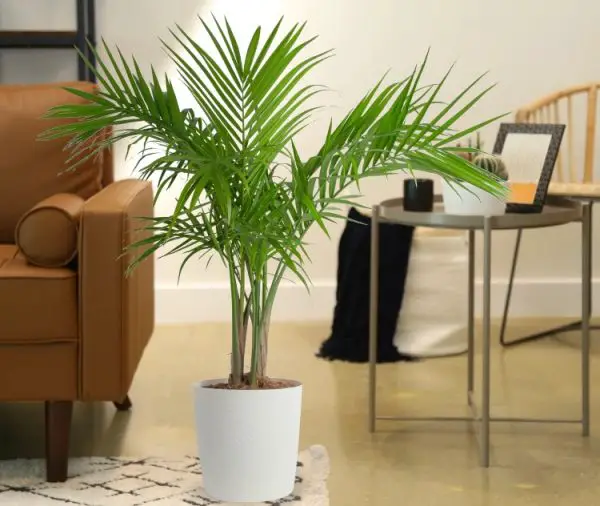The Majesty Palm (Ravenea rivularis), with its elegant fronds and towering stature, is a popular choice for both indoor and outdoor gardening enthusiasts. Native to the tropical regions of Africa, this stunning palm brings a touch of the exotic to any space, creating a lush, inviting atmosphere.
However, while Majesty Palms are relatively easy to care for, they do have specific needs that must be met to ensure they thrive.
This comprehensive guide will walk you through everything you need to know about growing and caring for Majesty Palms, from understanding their light and water requirements to recognizing common problems and implementing effective solutions.
About Majesty Palm

The Majesty Palm, also known as the Majestic Palm, is a popular indoor and outdoor plant native to Madagascar, Africa. It belongs to the Arecaceae family and is admired for its elegant, arching fronds that give any space a tropical feel.
This plant can vary greatly in size, maturing anywhere from 10 to 100 feet tall and spreading 6 to 20 feet wide, depending on its environment. Majesty palms thrive in partial sunlight, making them well-suited for both shaded outdoor spots and bright indoor locations.
For optimal growth, Majesty Palms prefer moist, well-drained soil with an acidic pH, mimicking the conditions of their natural riverbank habitats. They do well in hardiness zones 10-11 of the USDA plant hardiness scale, which means they can only survive year-round outdoors in warm, tropical climates.
While these palms are slower to grow indoors, with proper care and attention, their lush green fronds can elevate the beauty of any home or garden space.
Majesty Palm Care
To ensure Majesty Palm thrives, it should be placed in a spot with bright, indirect light and given a few hours of morning or afternoon sun through a window. Balancing the right amount of light is crucial for healthy growth.
Majesty Palms require careful attention to several key factors, including heat, light, and fertilization. These tropical plants are known for being a bit temperamental, so maintaining the right balance of these elements is essential. Too much direct sunlight can scorch the fronds, while too little light can stunt their growth. Proper care will result in lush, vibrant palms.
Light Requirements for Majesty Palms
In their natural habitat, Majesty Palms grow as understory plants, thriving in the dappled light beneath larger trees. When grown indoors, they need plenty of bright, indirect light to mimic these conditions. Providing them with a few hours of direct sun, ideally from a window in the morning or late afternoon, can help promote healthy growth.
However, placing Majesty Palms in full, direct sunlight for extended periods can lead to sunburned leaves. If you notice your plant stretching or becoming leggy, this may be a sign it needs more light. In such cases, move the palm to a brighter location without exposing it to harsh sunlight.
Soil Requirements for Majesty Palms
For Majesty Palms to thrive, it’s essential to provide the right growing medium. These tropical plants prefer a standard potting mix that is both moisture-retentive and well-draining. Adding extra peat to the mix is beneficial, as it not only improves the soil’s water-holding capacity but also enhances the acidity, which is ideal for the palm’s growth.
Majesty Palms are acid-loving plants, and they perform best in soil with a pH level as low as 5. This acidic environment helps the plant absorb nutrients more effectively, contributing to vibrant, lush foliage.
Proper drainage is crucial for Majesty Palms, as their roots are particularly sensitive to being waterlogged. Without adequate drainage, excess water can accumulate around the roots, leading to root rot, a condition that can quickly kill the plant.
To avoid this, ensure the pot has drainage holes and consider using a saucer beneath the pot to catch excess water. Regularly checking the soil’s moisture level and letting the top few inches of soil dry out between waterings can help maintain the right balance.
Watering Requirements for Majesty Palms
Maintaining the right moisture level in the soil is vital for the health of Majesty Palms. It’s essential to keep the potting media evenly moist, ensuring that it does not become waterlogged, as excess moisture can lead to root rot. On the other hand, allowing the soil to dry out too much between waterings can have detrimental effects; specifically, it can cause the plant to lose its lower leaves, leading to an ugly appearance and stunted growth.
To avoid these issues, it’s important to monitor the moisture level regularly. A good practice is to check the top inch of the soil; if it feels dry, it’s time to water. When watering, be thorough, allowing water to drain out of the bottom of the pot to ensure the roots are adequately hydrated.
Temperature and Humidity Requirements for Majesty Palms
Majesty Palms thrive in a temperature range of 65 to 85 degrees Fahrenheit, making them well-suited for indoor environments. While they prefer high humidity, they are adaptable and can survive in typical household humidity levels. In drier homes, especially during winter months, running a humidifier can significantly benefit the plant’s overall health and vigor.
Maintaining adequate humidity helps keep the leaves lush and prevents browning at the tips. Additionally, low humidity levels can create an inviting environment for insect pests, which may stress the plant. Therefore, it’s essential to monitor both temperature and humidity to ensure your Majesty Palm remains healthy and vibrant.
Fertilizer Requirements for Majesty Palms
To promote healthy growth, Majesty Palms should be fed with a weak, liquid fertilizer once or twice during the growing season, typically in spring and summer. It’s important to refrain from fertilizing during the winter months, as the plant’s growth slows down and it requires less nutrition.
If you notice your indoor palm plant beginning to stretch out, this may be a sign of over-fertilization; in such cases, it’s advisable to reduce or stop fertilizing altogether. A fertilizer mix designed for cacti is an excellent choice, as it provides the right balance of nutrients without overwhelming the plant.
Pruning Requirements for Majesty Palms
Pruning is not entirely necessary for Majesty Palms; however, for aesthetic reasons, you may wish to remove any fronds that have turned brown or yellow. Keeping your palm looking tidy can enhance its overall appearance.
When pruning, it’s essential to use clean pruners or shears to ensure a clean, sharp cut without tugging on the plant. This minimizes the risk of damaging the healthy fronds and helps prevent any potential infections. Regularly inspecting the plant and removing any dead or damaged leaves will contribute to a healthier and more visually appealing Majesty Palm.







